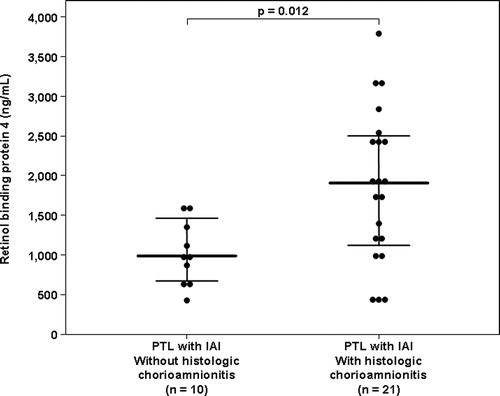Figures & data
Table I. Demographic and clinical characteristics of women with normal pregnancies in the mid-trimester and at term, with and without spontaneous labor.
Table II. Demographic and clinical characteristics among women presenting with spontaneous preterm labor (PTL) and intact membranes.
Figure 1. Amniotic fluid concentrations of retinol-binding protein 4 (RBP4) in normal pregnancies in the mid-trimester and at term, in labor and not in labor. The median amniotic fluid RBP4 concentration was higher in women in the mid-trimester than in those at term not in labor [1861.1 ng/ml, interquartile range (IQR) 1486.2–2034.3 vs. 766.1 ng/ml, IQR 608.5–1154.1; p < 0.0001]. Among women at term, the median amniotic fluid RBP4 concentration did not differ significantly between women in labor and those not in labor (term not in labor: 766.1 ng/ml, IQR 608.5–1154.1 vs. term in labor: 836.8 ng/ml, IQR 589.5–1112.8; p = 0.4). The black lines represent the median and IQR.
![Figure 1. Amniotic fluid concentrations of retinol-binding protein 4 (RBP4) in normal pregnancies in the mid-trimester and at term, in labor and not in labor. The median amniotic fluid RBP4 concentration was higher in women in the mid-trimester than in those at term not in labor [1861.1 ng/ml, interquartile range (IQR) 1486.2–2034.3 vs. 766.1 ng/ml, IQR 608.5–1154.1; p < 0.0001]. Among women at term, the median amniotic fluid RBP4 concentration did not differ significantly between women in labor and those not in labor (term not in labor: 766.1 ng/ml, IQR 608.5–1154.1 vs. term in labor: 836.8 ng/ml, IQR 589.5–1112.8; p = 0.4). The black lines represent the median and IQR.](/cms/asset/ad4127c0-106c-47ea-aefe-09d9903bda48/ijmf_a_399645_f0001_b.jpg)
Figure 2. Amniotic fluid concentration of retinol-binding protein 4 (RBP4) among women with spontaneous preterm labor and intact membranes (PTL). The median amniotic fluid RBP4 concentration was higher in patients with intra-amniotic infection/inflammation (IAI) than in women with PTL without IAI who delivered preterm [1268.9 ng/ml, interquartile range (IQR) 900.3–1970.1 vs. 815.8 ng/ml, IQR 592.4–1098.1; p < 0.001], and than those with PTL without IAI who delivered at term (828.7 ng/ml, IQR 499.7–1119.6; p < 0.001). Among women with PTL without IAI, there was no difference in the median amniotic fluid concentration of RBP4 between those who delivered preterm and those who delivered at term (p = 0.7). The black lines represent the median and IQR.
![Figure 2. Amniotic fluid concentration of retinol-binding protein 4 (RBP4) among women with spontaneous preterm labor and intact membranes (PTL). The median amniotic fluid RBP4 concentration was higher in patients with intra-amniotic infection/inflammation (IAI) than in women with PTL without IAI who delivered preterm [1268.9 ng/ml, interquartile range (IQR) 900.3–1970.1 vs. 815.8 ng/ml, IQR 592.4–1098.1; p < 0.001], and than those with PTL without IAI who delivered at term (828.7 ng/ml, IQR 499.7–1119.6; p < 0.001). Among women with PTL without IAI, there was no difference in the median amniotic fluid concentration of RBP4 between those who delivered preterm and those who delivered at term (p = 0.7). The black lines represent the median and IQR.](/cms/asset/086fc915-ddb9-4318-93b7-13e9889921a2/ijmf_a_399645_f0002_b.jpg)
Table III. A backward stepwise, multivariable logistic regression model including IAI as the dependent variable and maternal age, pre-pregnancy BMI, smoking status, gestational age at amniocentesis and amniotic fluid RBP4 concentration ≥1149.8 ng/ml as covariates.
Figure 3. Amniotic fluid concentrations of retinol-binding protein 4 (RBP4) among women with spontaneous preterm labor (PTL) and intra-amniotic infection/inflammation (IAI) who delivered within 72 h of amniocentesis and have placental histopathologic diagnosis. The median amniotic fluid RBP4 concentration was significantly higher in patients with IAI and histologic chorioamnionitis than in women with IAI without histologic chorioamnionitis [1901.0 ng/ml, interquartile range (IQR) 1107.3–2492.0 vs. 968.2 ng/ml, IQR 634.7–1396.7; p = 0.01]. The black lines represent the median and IQR.
![Figure 3. Amniotic fluid concentrations of retinol-binding protein 4 (RBP4) among women with spontaneous preterm labor (PTL) and intra-amniotic infection/inflammation (IAI) who delivered within 72 h of amniocentesis and have placental histopathologic diagnosis. The median amniotic fluid RBP4 concentration was significantly higher in patients with IAI and histologic chorioamnionitis than in women with IAI without histologic chorioamnionitis [1901.0 ng/ml, interquartile range (IQR) 1107.3–2492.0 vs. 968.2 ng/ml, IQR 634.7–1396.7; p = 0.01]. The black lines represent the median and IQR.](/cms/asset/6dcb8b41-b97c-452c-96fd-79a93501fb2f/ijmf_a_399645_f0003_b.jpg)
Figure 4. The receiver–operating characteristic (ROC) curve of amniotic fluid RBP4 concentration for the identification of IAI among patients with PTL with intact membranes (area under the curve (AUC) 0.71, p < 0.001). Derived from this ROC curve, a cutoff value for amniotic fluid RBP4 concentration of ≥1149.8 ng/ml had a sensitivity of 58.9% and a specificity of 79.8% for the identification of IAI in patients with PTL and intact membranes.
